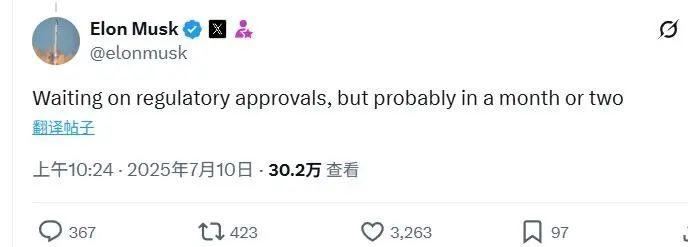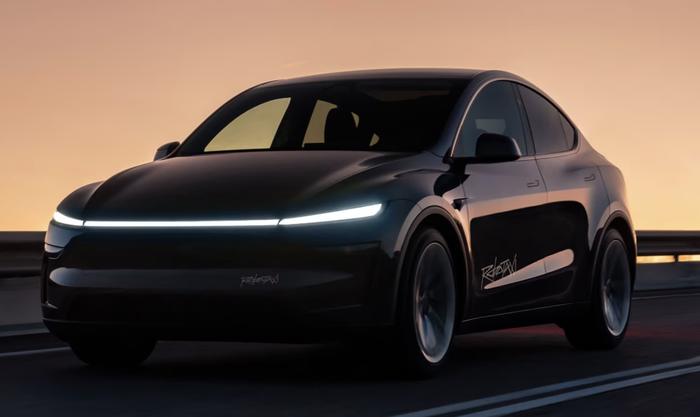

On Wednesday Eastern Time, Elon Musk, CEO of Tesla, stated that, with the approval of regulatory authorities, Tesla will expand its Robotaxi service to the San Francisco Bay Area within “one or two months.”
On July 10th local time, Tesla’s stock price surged, rising nearly 4% at one point and closing at $304.19 per share, up 2.81%.
Musk: Plans to Expansion in San Francisco Bay Area Within Two Months
On June 22nd Eastern Time, Tesla launched Robotaxi services in a region in Austin, Texas, USA.
Although Robotaxi has been highly anticipated, so far, Tesla’s trial operations for the Robotaxi seem quite low-key: only about a dozen vehicles are available for service, the scope of activities is limited, and throughout the Robotaxi service period, there is always a Tesla employee seated in the passenger seat.
This Wednesday Eastern Time, when X users on social media complained about Tesla not updating them about the expansion of Robotaxi services in a timely manner, Musk responded by saying that Tesla would extend its service to “a larger area in Austin this weekend.”
When asked about the expansion plan in the Bay Area, Musk said, “We are waiting for regulatory approval, but it might be within one or two months.”
For a long time, Musk has regarded autonomous driving as the next significant driver of Tesla’s profitability, especially given Tesla’s ongoing sales decline over more than a year.
However, nearly three weeks after the launch of Robotaxi, Tesla has so far not disclosed any specific performance details about the service. From videos currently exposed on social media, it seems that Tesla’s Robotaxi has made several instances of reckless driving or violations of traffic regulations during its operation.
On July 6th, local time, the first collision incident occurred in the Robotaxi autonomous taxi project.
A video posted by tech blogger “DirtyTesla” showed a Tesla Robotaxi suddenly accelerating and turning on its own after completing its route, bumping into a stationary vehicle.
Currently, regulatory authorities have requested Tesla to explain the operational logic and technical details involved.
Although the accident did not result in any casualties, it has become a question mark over Tesla’s technology roadmap, specifically the “pure vision” autonomous driving solution, given that it occurred during the testing phase of the Robotaxi project.
According to “DirtyTesla,” a Tesla FSD user and blogger, he was riding a fully autonomous Model Y test car to a pizza shop when the vehicle failed multiple attempts to enter the parking lot and ended up parked next to the entrance. The video he recorded after getting out shows the car suddenly turning the steering wheel on its own and heading straight towards a Toyota Camry parked nearby.
The tires lightly scraped the other car’s door before the Tesla automatically stopped and flashed the hazard warning light.
This video was released online on June 24th. So far, Tesla has not responded to this incident. Although the scratches were not severe, their occurrence during the Robotaxi testing period and being clearly documented by the public means that their symbolic significance far exceeds the loss itself.
Not only has the Tesla Robotaxi been involved in several operational anomalies, including:
– A Robotaxi driving into the opposite lane during a left turn and proceeding in reverse for several seconds;
– Several instances of “ghost braking” where vehicles abruptly stop without apparent obstacles, causing passenger items to fall;
– Incorrect recognition of drop-off locations, resulting in the vehicle stopping in the middle of the lane or at a traffic light, forcing the end of the trip;
– Testers have recorded Robotaxis traveling nearly 40 miles per hour within a speed limit of 30 miles.
In response, Tesla has consistently withheld operational data and did not proactively disclose the FSD takeover frequency or specific fault logs.
This attitude of “not explaining, not responding” is exacerbating concerns between regulatory bodies and the public.
Following a collision incident, the National Highway Traffic Safety Administration (NHTSA) has quickly intervened.
The NHTSA has issued an official information request to Tesla.
It demands that the company submit the perception logic of the vehicle at the time of the collision, the control decision chain, the abnormal response mechanism, as well as an overall evaluation framework for the current version of the Robotaxi system.
The NHTSA stated that they are conducting information collection under an assessment framework based on potential systemic defects and will decide whether further regulatory action should be taken.